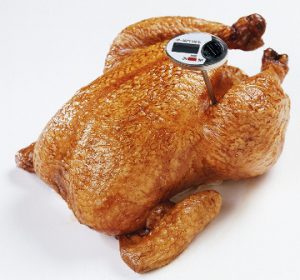 Have you ever been frustrated that you prepared a home cooked meal and everyone complained that the meat was tough? The answer can be as simple as using a thermometer to cook to the right temperature.
Have you ever been frustrated that you prepared a home cooked meal and everyone complained that the meat was tough? The answer can be as simple as using a thermometer to cook to the right temperature.
Why Use a Food Thermometer?
I’ve become a much better cook now that I regularly use a thermometer when cooking meats. My pork tenderloins are no longer dry and roast chicken is perfectly cooked. I also know that my food has been cooked to the minimum temperature needed to ensure food safety. Looks can be deceiving when deciding if something is thoroughly cooked. Meat that is no longer pink may not have been cooked to the safe temperature, and some that are pink have been. The only way to be sure is to check the temperature.
Choosing a Food Thermometer

There are a variety of thermometers readily available. My personal favorite is the digital cooking probe type. They usually cost less the $20. The probe is inserted into the food and an attached ovenproof cord is run out to the countertop unit. The unit displays the temperature and can also be used as a timer. Just program for the required temperature and an alarm will sound when your meat has reached the correct temperature. Bluetooth versions are also available so that you can track temperature on your smart phone.
Other types of thermometers include an ovenproof meat thermometer and instant-read non-heat resistant types in dial and digital versions. No matter what type you choose, follow a few basic rules.
Using a Food Thermometer
-

Instant-read Thermometer Insert sideways into thin cuts of meat such as hamburgers and chicken breasts.
- Thermometer should be placed in the thickest part of the meat and not touching bone, fat or gristle.
- Clean after each use with hot soapy water.
- Some foods require a rest time. This is the amount of time that the food allowed to rest after cooking.
USDA Recommended Safe Minimum Internal Temperature
| Minimum Temperature | Rest time | |
| All poultry products including ground chicken and turkey | 165°F | none |
| Ground meats other than poultry | 160°F | none |
| Beef, pork, veal and lamb steaks, roasts and chops | 145°F | 3 minutes |
| Fish | 145°F | none |
For More information:
Keeping Food Safe: Choosing and Using Food Thermometers in Homes
 0
0

